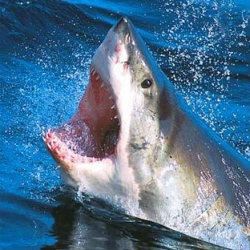
In a study published Wednesday, Hopkins Marine Station in Pacific Grove researchers discovered that sharks share that characteristic with many birds, whales and other creatures.
The great white shark will store fat in the liver and use it for energy as it moves along on its trek. This has been the first time any study has found sharks to be capable of doing this.
"It’s fairly well described where the sharks go to, thanks to all of these tagging experiments. But everyone wants to know how they do it and why they do it," said the study’s lead author, Gen Del Raye. "Using the data, we were able to find that out."
Del Raye began the study as a summer intern at Hopkins while an undergraduate of Stanford University. He came up with the idea to test how the density of fat stored in the shark’s liver played a role in its buoyancy.
"Great white sharks use a swim-glide pattern," Del Raye said. "For some period the shark stops actively swimming and glides. As it sinks, the shark glides forward. If you have a shark that has more fat, it will sink more gradually."
The study answers questions about how sharks can make non-stop trips more than 2,000 miles and maintain their buoyancy.
